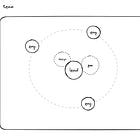This is a continuation of my piece about The Atomic Team, but it can be read independently.
How do you keep a team’s nucleus closely aligned, such that it keeps the wider team orbiting in a stable and predictable way?
Ensure the feedback loops are as small as possible.
As a reminder, I define the nucleus of the team as the central point of accountability. It is the touchpoint where external parties interface with the team: for example, to request a new feature, to ask what the timelines are, to report a bug. It is also where those incoming signals are processed and disseminated to the wider team, in the form of standup updates, dedicated meetings, tickets, etc.
The nucleus is often just one or two people. In a value stream (or product) team, it often consists of a tech lead and a product manager.
Practically speaking, I’d recommend that the nucleus has a dedicated time to meet once a day. In the past, I’ve found that 10-15 minutes before the team standup works well.
If the nucleus is newly formed, you might need a bit longer or even more frequent check-ins throughout the day to get into sync. Once you’ve found your rhythm and have clear ideas about what each other is working on and what the pace of progress is, skipping some days or just doing asynchronous updates becomes feasible.
But don’t jump there too early. The spinning plate doesn’t take much to start wobbling.
This is a profoundly simple, and indeed even obvious practice. Yet you’d be amazed at how few teams follow it and how transformative it can be once they do.
That alignment, sense of purpose and proactive addressing of niggles before they become problems is infectious. The rest of the team can’t help but pick up on it, and begin to follow suit, whether they’re aware of it or not. It’s like being swept along by a current. And it begins to seep into every aspect of software delivery, from the written code to the deployment cycle.
Model fast feedback loops, and watch your teams' momentum accelerate.


